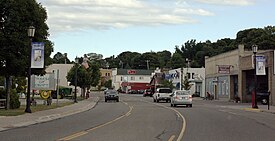St. Ignace, Michigan | |
|---|---|
| City of Saint Ignace[1] | |
 Downtown St. Ignace along BL I-75 in 2011 | |
| Motto: Gateway to Michigan's Upper Peninsula[2] | |
 Location within Mackinac County | |
| Coordinates: 45°51′57″N 84°43′33″W / 45.86583°N 84.72583°W | |
| Country | United States |
| State | Michigan |
| County | Mackinac |
| Settled | 1671 (St. Ignace Mission) |
| Incorporated | 1882 (village) 1883 (city) |
| Government | |
| • Type | Mayor–council |
| • Mayor | Willie LaLonde |
| • Manager | Darcy Long |
| • Clerk | Andrea Insley |
| Area | |
• Total | 2.65 sq mi (6.86 km2) |
| • Land | 2.64 sq mi (6.83 km2) |
| • Water | 0.01 sq mi (0.03 km2) |
| Elevation | 587 ft (179 m) |
| Population | |
• Total | 2,306 |
| • Density | 874.15/sq mi (337.56/km2) |
| Time zone | UTC-5 (Eastern (EST)) |
| • Summer (DST) | UTC-4 (EDT) |
| ZIP code(s) | 49781 |
| Area code | 906 |
| FIPS code | 26-70840[5] |
| GNIS feature ID | 1627027[1] |
| Website | Official website |
St. Ignace (/ˈɪɡnəs/ IG-nəss) is a city in the U.S. state of Michigan and the county seat of Mackinac County.[6] The city had a population of 2,306 at the 2020 census.[4] St. Ignace Township is located just to the north of the city; the two are administered separately.
St. Ignace is located along Lake Huron in the Upper Peninsula on the northern side of the Straits of Mackinac. The city serves as a gateway to the state's Upper Peninsula for travelers coming from the Lower Peninsula, as the city is at the north end of the Mackinac Bridge, opposite Mackinaw City. It has one of two ports which provide ferry service to nearby Mackinac Island.
St. Ignace's history dates back to 1671 when French Jesuit priests founded the St. Ignace Mission, which makes it one of the oldest European settlements in the state after Sault Ste. Marie. The area was previously inhabited by the Wyandot people, as well as the Ojibwe and Ottawa tribes of Native Americans. St. Ignace soon became the center of fur trading with the French. It was incorporated as a village in 1882 and a city in 1883. The Mackinac Bands of Chippewa and Ottawa Indians is headquartered at St. Ignace, and the city continues to have a high population of Native Americans.
- ^ a b U.S. Geological Survey Geographic Names Information System: St. Ignace, Michigan
- ^ City of St. Ignace (2019). "The City of St. Ignace". Retrieved April 17, 2019.
- ^ "2022 U.S. Gazetteer Files: Michigan". United States Census Bureau. Retrieved June 13, 2023.
- ^ a b "P1. Race – St. Ignace city, Michigan: 2020 DEC Redistricting Data (PL 94-171)". U.S. Census Bureau. Retrieved June 13, 2023.
- ^ "U.S. Census website". United States Census Bureau. Retrieved January 31, 2008.
- ^ "Find a County". National Association of Counties. Retrieved June 7, 2011.

